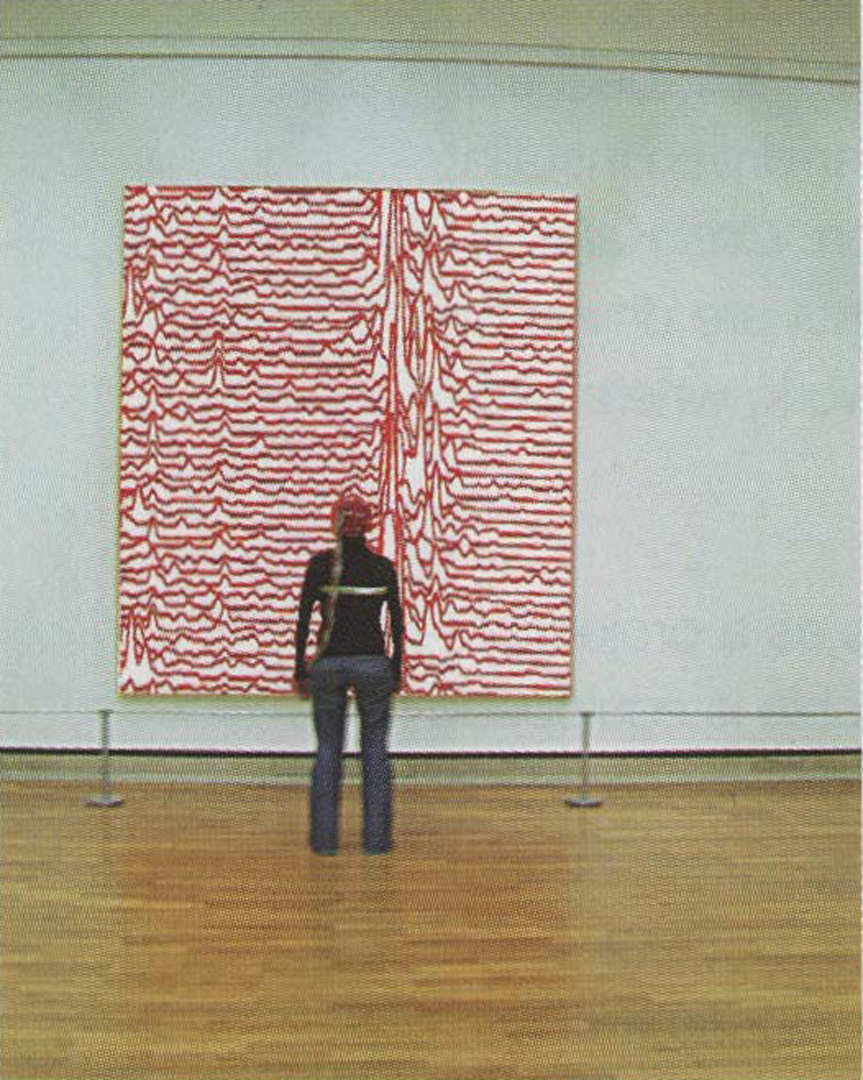Adi Hoesle: the appearance of cerebration
Artist(s):
Title:
- the appearance of cerebration
Exhibition:
Creation Year:
- 2004
Medium:
- Wallpaper wood
Size:
- wallpaper 1.5 meters x 3.5 meters sculpture 0.2 meters x 0.3 meters x 0.1 meters
Category:
Artist Statement:
Data from measurements of brain waves are transformed into a wallpaper pattern and a three-dimensional sculpture. The sensory organs that are stimulated and inspired by looking at art and associated cerebral events are performing as artwork themselves. The sum of senses plus awareness equals the true sense. This would be defined as “synesthetik.” Wallpaper: The wallpaper project literally uses the “neuronal pattern” as a pair of terms and transforms them in a visualized context (perception). A viewer was asked to look at the famous painting “Who is afraid of red, blue and yellow” by Barnett Newmann in the Staatsgalerie in Stuttgart, Germany, and the viewer’s cerebral
responses (wave patterns) were transformed into paper wall strips. Brain sculpture: For the “brain sculpture,” the wave patterns were milled in a precise landscape-like sculpture of wood or plastic. Concept: Electroencephalography (EEG) allows measurement of brain activities in real time. Cerebral activities are defined as neuronal patterns and interpreted as perception. In general, more activity is found in the right hemisphere when the subject is being creative. And cerebral activity increases during perception. In this work, EEG measurements allow the observer to perceive brain activity during perception of an aesthetic event. Summary: EEG technology can reveal perceptive activities within the brain of the artist as well as in the brain of the recipient. Thus mental processes that are triggered during artistic events are not limited to the brain’s interior, but may also be reflected in a two-dimensional “picture” or “in” a three-dimensional sculpture.
Technical Information:
The so-called “human factor” is presented opposite to an increasingly digitized and herewith dematerialized society of information. The binary code reflects the cerebral procedures: 0 and 1 stand for: will a stimulus be transmitted: yes or no? The result is defined as network. When the different centers, from the retina up to the brain, simultaneously interact in a network, we are able to see the appearance of cerebration subjects the interface between hardware and software, and between the cerebral and spiritual processes, to a combination of PC and EEG and reflects interior processes. The reflection is an aesthetic product manufactured with modern procedures (digital print, computer-assisted CNC-milling machine). EEG: EEGs are recorded with a Medtronic Ambulatory. The recorded signal is in the frequency range of 1 -15 Hz. Customized software, developed by Frieder Weiss, analyzes the wave pattern in real time and transforms it into a landscape-like picture by a Fast Fourier Transformation. Print: With digital print procedures, the cerebral signals can be processed.
Plastic Sculpture: The recorded data are transformed into IGES or DXF files for computer assisted machine systems and precisely rendered by a five-axle-driven CNC-milling machne. In all procedures, there is a permanent feedback mechanism: This area of technical awareness has the goal to detect people (humans) in the environment of computers, to identify them, and to investigate significant measurements. The goal of this method/technique is to investigate and interpret human actions through art. When processing the measured results of cerebral activities, the technique itself is being used as “cerebral activities” and will influence the result in the same way as the aesthetic result. This application, of course, doesn’t require a certain cerebral activity, but includes it as an integral. “Interface as Interface in the sense of bio-aesthetic feedback.”





